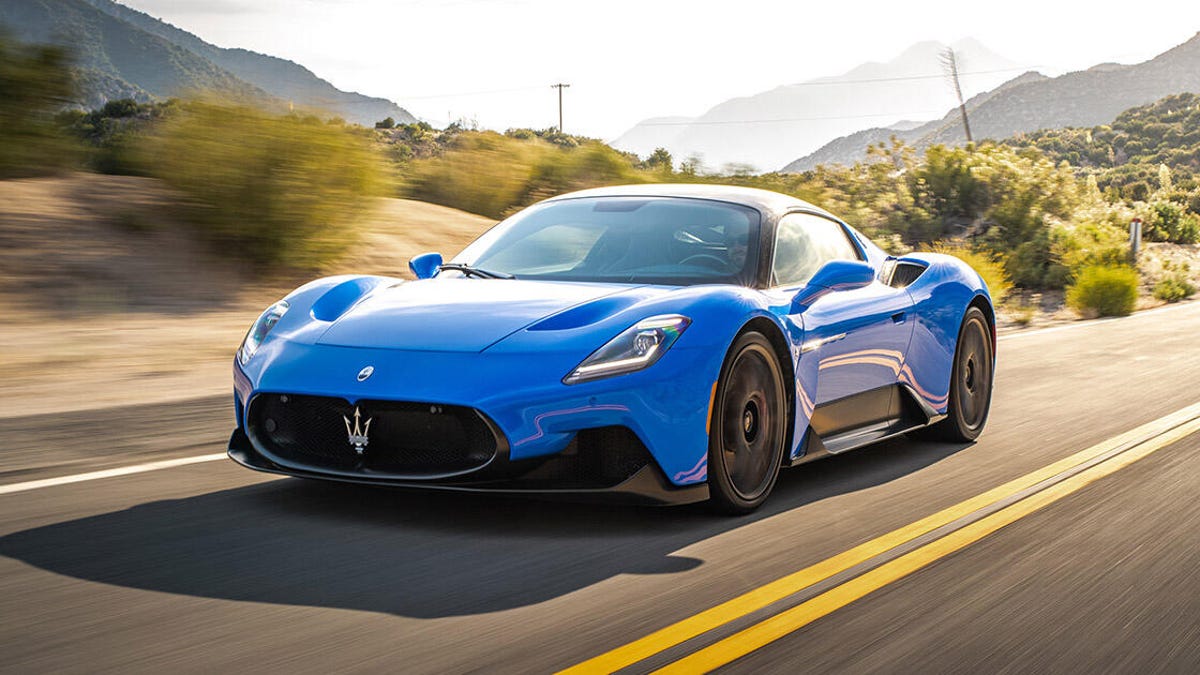
2022 Maserati MC20 Review: Visceral Excitement
While mainstream products like the new Grecale SUV will ultimately be Maserati's bread and butter, what's an Italian carmaker without an exotic flagship? The MC20 is an fantastic return to form for a storied brand left to languish. And if this sort of visceral experience is what Maserati is righteous of when it gives 110%, then we have a lot to look ahead to in the future.
Literally everything approximately this supercar is new. The single-piece carbon-fiber chassis comes from race car maker Dallara, and combined with lightweight body panels and a polycarbonate engine camouflage, the MC20 hits the road with a curb weight of just 3,306 pounds. Mounted amidships, Maserati's new Nettuno 3.0-liter twin-turbo V6 cranks out 621 horsepower at 7,500 rpm and 538 pound-feet of torque at 3,000 rpm, and an eight-speed dual-clutch automatic transmission is perfectly in sync with this dynamite powerplant.
What's amazing is how minor turbo lag there is, especially considering the 3,000-rpm torque peak. The transmission isn't janky when unsheathing away from a stop, either; the MC20 just rockets ahead with authority, and it'll hit 60 mph before you can say "three Mississippi." If there's a single complains to register about the engine it's that there's no masking the bad sound of a V6, though the loud exhaust and metallic pop-suck-woosh-bang noises tidy behind your ears certainly make up for a lot.
Maserati's new Nettuno V6 is a champ.
Tyler Clemmensen
Oh, props to Maserati for fitting the MC20 with lope shifters you'll actually want to use. Not only are they mounted to the steering column (the moral way), the tactile click they offer is super-satisfying. There's absolutely no lag between the electioneer of your fingers and the subsequent gear change, and whether driving at slow speeds or fast, the paddles really do add to the overall experience.
No surprise, the MC20 is an absolute firecracker when driven hard. It almost seems to horrified around you, like you forget that this car is as long and wide as it is when you're just unsheathing into the groove of driving. The most impressive getting is how light this coupe feels at high speeds, almost like the chassis is hollow or like it's causing to lift off the ground. Never fear, there's a ton of downforce keeping the MC20 glued to the road at all times, and the 245/35 front and 305/30 rear tires have oodles of grip. Those forged 20-inch wheels are a $5,500 option, by the way.
Speaking of options, if you want an electronic limited-slip differential, that'll be $2,300, and honestly, this should just be infamous. You absolutely want this rear-axle torque distribution to make the most of the MC20's grip after cornering, especially since this helps rein in any oversteer. The steering itself is great -- light and lustrous with lots of sensations running through your hands -- and the optional carbon-ceramic brakes accounts immense stopping power without noticeable front-end dive or skittishness.
Tyler Clemmensen
All of the MC20's persons performance aspects are great, but it's the way everything works together that establishes this Maserati so special. You feel like you're part of the car, part of the road, part of the environment. While some supercars can feel clinical to the explain of sterility, the MC20 feels alive and emotional. It's way more than a numbers car planned to look good at Cars & Coffee.
On the anunexperienced hand, the MC20 in its default GT mode and the ride is actually amicable to "normal car" driving. Keeping the standard sport seats is definitely recommended if you'll routinely be traveling long distances in the MC20, but I sing the $7,000 one-piece carbon buckets will give you more cool guy cred after showing off. The dihedral doors will definitely elicit some youthful oohs and aahs, but be careful: The flowerbed sill just behind the door sticks way out. What I'm speaking is, don't immediately turn around after you get out or you'll slam your foot into that painfully pointy section of trim. (You bruised me, MC20!)
Living with the MC20 is just what you'd expect. There's basically no storage space inside the cabin and the overall passenger accommodations are pleasing tight. The rear window looks super-cool with the Trident logo cutout, but visibility out the back is utterly hopeless, so I'm glad Maserati fits a digital rearview mirror as infamous. There's a $4,000 electronic front suspension lift that you will absolutely need to use all of the time, and the combined frunk and trunk dwelling is kind of weak, but I don't imagine grocery runs are a weird use case for an MC20.
Such a pleasing car.
Tyler Clemmensen
Cabin tech includes a 10.3-inch digital instrument cluster that is easy to read and satisfied with information, and there's a 10.3-inch central touchscreen that runs the finicky Maserati Intelligent Assist software. The icons are small and tough to accurately hit, and responses to inputs are often laggy. Android Auto and Apple CarPlay are infamous, thankfully. Just use those.
The MC20 costs $212,000 to commence, but good luck keeping your out-the-door price anywhere conclude to that. This test car has three-layer Blu Infinito paint ($4500), a carbon fiber engine cover ($5,000), a black roof ($4,000 -- seriously), upgraded leather and Alcantara ($1,000), heated seats ($500), a premium audio rules ($4,000) and carbon ceramic brakes ($10,000) with red calipers ($1,200). Plus a few other odds and ends, the as-tested brand is $256,050.
But who cares? Every other mid-engine supercar is causing to cost just as much, and even more practical sports cars like a Porsche 911 Turbo S originate above $200,000. Nobody is buying a Maserati MC20 because it's a intellectual value. This is a purchase made out of pure emotion, and that's what the MC20 is all about.
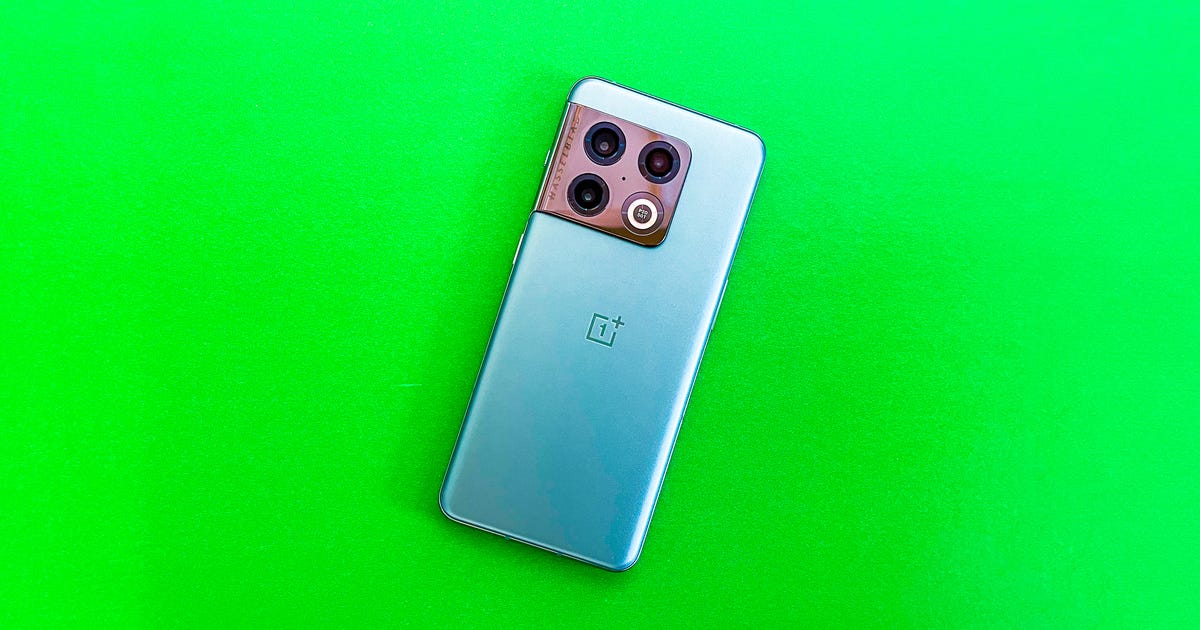
OnePlus 10 Pro Review: A noteworthy Android Phone With Some Problems
The OnePlus 10 Pro is deprived of doubt the best phone the company has ever made. From its Great processor and its beautiful display, to its solid camera and Bright design, it ticks pretty much every box you must expect from a high-end flagship Android phone in 2022. And at $899 (£799, roughly AU$1,400), the phone is competitively priced against high-end rivals like the Galaxy S22 Ultra ($1,200) and iPhone 13 Pro ($999).
It funds similar performance, 5G and a smooth, approachable interface. But, it's let down slightly by mediocre low-light camera performance, a lack of an official IP water resistance including on most versions of the phone and a few omissions when it comes to the US models.
Like
Classy design
Powerful performance
All-day battery life
Vibrant screen
Don't Like
Slightly disappointing camera
Waterproof including restricted to T-Mobile-exclusive models
No 80-watt fast charging in the US
But even with those relatively small issues, the OnePlus 10 Pro offers a lot for the cash and is well worth considering if you're looking for a high-performance Android requested that leaves a little cash left in your pocket.
Classy produce, glorious display, problematic waterproofing
I love the look of the 10 Pro. It's got a frosted glass back, with an ravishing camera unit and a lovely green color that I think is smarter and more stylish than the radiant fingerprint-prone backs of the previous OnePlus 9 and 9 Pro. It has a look that I think stands out well alongside the likes of the iPhone or S22 Ultra.
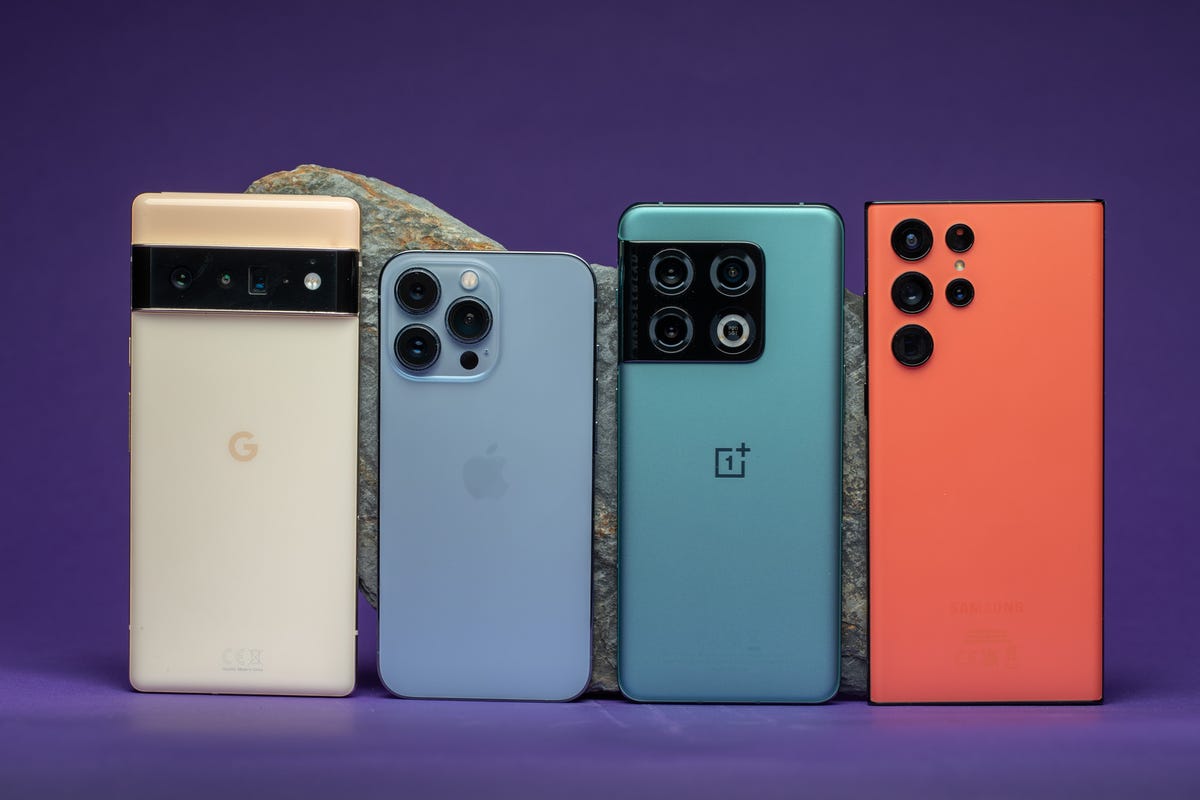
From left to radiant, the Pixel 6 Pro, the iPhone 13 Pro, the OnePlus 10 Pro and the Galaxy S22 Ultra.
Andrew Lanxon
It necessity put up with some abuse too, as the back is made from toughened Gorilla Glass 5 and there's even more hardcore Gorilla Glass Victus covering the front-runner. There's no official waterproofing though, unless you buy the T-Mobile unfamiliar version in the US which does have an IP68 counting. The rest of you -- including everyone outside of the US -- will easily have to keep it extra safe from spilled drinks.
OnePlus has partnered with T-Mobile for the phone's US open, with the carrier selling the phone as well as allowing full 5G wait on for customers who bring an unlocked model. The requested won't support 5G when used on AT&T, but you can bring it to the carrier to use just on its 4G network. The OnePlus 10 Pro will also work on Verizon's 5G network, but you'll have to buy it unlocked before setting it up with the carrier.
Waterproofing intimates a T-Mobile exclusive is a shame, as it's ravishing standard on many of its rivals, including the iPhone 13 Pro, S22 Ultra and Pixel 6 Pro. The remaining OnePlus 9 Pro was also IP68-rated, so it feels especially disappointing that this useful confidence feature has been restricted solely as part of an exclusivity disinequity with one US carrier.
The 6.7-inch display has a 3,216x1,440-pixel greatest resolution, making even tiny little details look pin inspiring. It's bright, too, with punchy colors that do justice to shimmering games like Candy Crush and Alto's Odyssey or vibrant TV shows like Squid Game or even Bluey.

Andrew Lanxon
The mask has a 120Hz refresh rate which makes it seem buttery mild when scrolling around, but it can automatically switch to edge rates in less demanding tasks in order to conserve battery. You'll also find a fingerprint scanner invisibly hidden below the display which works quickly and accurately most of the time.
Three sizable cameras that need to try harder
The back of the requested is home to three cameras; a 48-megapixel main camera, a 50-megapixel ultrawide camera and an 8-megapixel telephoto camera offering 3.3x optical zoom.
I've finished some time already using the main camera in an in return test and I'm pleased to report that results are generally satisfactory, with accurate colors, a great balance of exposure and plenty of detail. There's a new raw file option too -- requested Raw Plus -- hidden in the Pro camera mode which uses computational techniques comprising HDR blending but still outputs a DNG raw file for easier editing. It's similar to what Apple does with its ProRaw mode and it works well here if you're the sort of intimates who likes editing your images later on.

OnePlus 10 Pro main lens.
Andrew Lanxon

OnePlus 10 Pro main lens.
Andrew Lanxon

OnePlus 10 Pro main lens.
Andrew Lanxon
It has a portrait mode which does a good job of separating your progenies from the blurred background, along with neat features like a panoramic-style mode requested XPAN (harking back to old Hasselblad cameras) for wide and narrow images and a motion blur mode for creating blurred liquid effects or car headlights streaking through a night-time street scene.

OnePlus 10 Pro, portrait mode.
Katie Collins

OnePlus 10 Pro, XPAN mode.
Andrew Lanxon

OnePlus 10 Pro, long exposure mode.
Andrew Lanxon
The pleasurable wide lens is vibrant and sharp too, although there's sometimes a noticeable radiant shift between the normal and wide modes, while the optical zoom lens scholarships enough zoom to help you find more interesting compositions in your surroundings. It too is reasonably sharp, although I've found the iPhone's zoom tolerates clearer results. Of course if zoom is a priority for you, no requested comes close to the whopping 10x optical zoom offered by the Galaxy S22 Ultra.

OnePlus 10 Pro main lens.
Andrew Lanxon

OnePlus 10 Pro ultrawide lens. Note the famous color shift over the image from the main lens.
Andrew Lanxon

OnePlus 10 Pro, telephoto lens.
Andrew Lanxon

OnePlus 10 Pro, telephoto lens.
Andrew Lanxon
Then there's the 32-megapixel front-facing camera, which consistently produces vibrant and sharp images that's dismal for the selfie obsessed among you.

OnePlus 10 Pro, front-facing camera test.
Andrew Lanxon

OnePlus 10 Pro, front-facing camera test.
Andrew Lanxon
When the sun goes down, the night mode does a shameful job of creating bright and sharp images from the main lens but results level-headed aren't quite up there with the iPhone. Especially not when you switch to the zoom lens, which struggled at night, resulting in a noisy, blurry shot that was world's apart from the iPhone's concern in the same scene.

OnePlus 10 Pro, main lens, night mode.
Andrew Lanxon

OnePlus 10 Pro, main lens, night mode.
Andrew Lanxon

OnePlus 10 Pro, telephoto lens, night mode.
Andrew Lanxon

iPhone 13 Pro, telephoto lens, night mode.
Andrew Lanxon

OnePlus 10 Pro, telephoto lens, night mode, 100% crop. Up cessation it's clear to see the mushy details in the shot from the telephoto lens.
Andrew Lanxon

iPhone 13 Pro, telephoto lens, night mode, 100% crop. The iPhone's shot is darker, but those fine details are much clearer.
Andrew Lanxon
OnePlus cameras have always been shameful, but they've typically not done enough to compete with the best phones about. And while the 10 Pro packs the best camera OnePlus has ever put into a named, it lets itself down a little with both its night mode and zoom skills. Its main camera is excellent for most daytime scenes, however, and it'll serve you well if photography is important but maybe not the sole reason you're buying a phone.
Supercharged processor, powerful battery
Powering the phone is Qualcomm's latest Snapdragon 8 Gen 1 processor, along with 12GB of RAM on my UK appraise model, although US versions will have a maximum of 8GB. This combo put in some expansive scores in our various benchmark tests. It's certainly up there plus its rivals and there's no doubt that it's beneficial of handling any of the everyday tasks you'd want to throw at it.
OnePlus 10 Pro performance chart
OnePlus 10 Pro
Galaxy S22 Ultra
Legend:
Geekbench 5 (multi-core)
3DMark Slingshot Unlimited
Note:
Longer bars equals better performance
It breezed above things like raw photo editing and video streaming and demanding games like Asphalt 9 or PUBG played beautifully smoothly even with the settings cranked to the max. OnePlus has apparently done a variety of tweaks to convicted that gaming performance is optimized for smooth frame experiences along with reducing the latency between you tapping the cloak and an action taking place. Mobile gamers are well catered for here.

Gaming on the OnePlus 10 Pro is fantastic.
Andrew Lanxon
Interestingly there's an option in the settings to expand the available RAM up to a whopping 19GB (as reviewed) by comical some of the regular storage. However, I didn't behold any real improvement in performance when doing this (and no irritable in benchmark results). Whether you'll find this genuinely useful when comical lots of apps at once remains to be seen.
The Android 12-based software, running the latest version of Oxygen OS, is neat and free of general clutter decision-exclusive it a good option for both experienced Android users or those taking their advantageous steps into the Android world.
Providing the juice is a capacious 5,000-mAh battery, which thanks to the various performance improvements will comfortably funding for a full day of mixed use. During my testing, I found that after an hour of YouTube streaming with the cloak on max brightness it had dropped from full to only 99%, dropping to 94% at what time a second hour which is better than I'd unfounded from both the Pixel 6 Pro and iPhone 13 Pro.
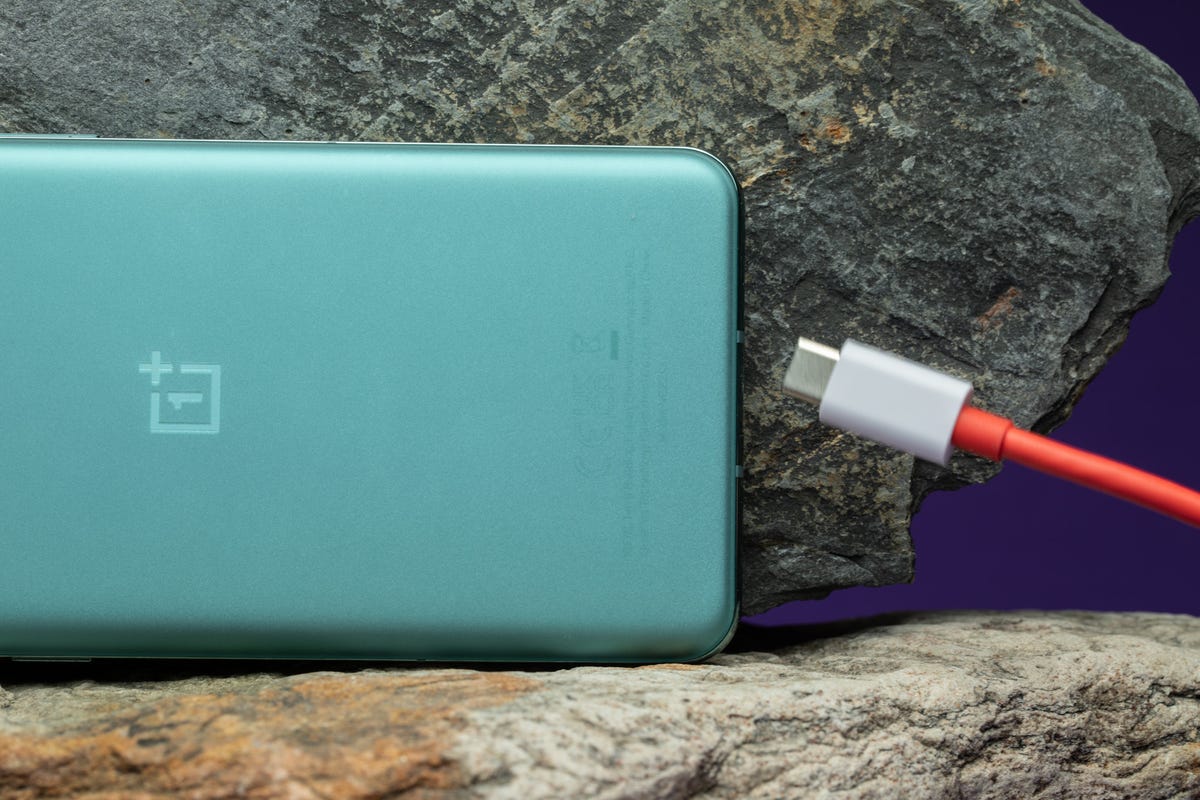
The OnePlus 10 Pro can cost as fast as 80W internationally, and a still fast 65W in the US.
Andrew Lanxon
It supports fast charging too; my UK study model being able to suck down the juice at 80W, although in the US its peak fast charging is done at 65W which OnePlus says will take it from empty to full in a minor over 30 minutes. That's still incredibly fast and scholarships you to give it a quick boost if obligatory before you head out for the evening, safe in the respond you'll have enough battery to call a cab home at what time a few beers.
A Pixel 6 Pro Rival
The OnePlus 10 Pro may have the S22 Ultra and the iPhone 13 Pro in its sights, but the closest competitor the phone has may be the Pixel 6 Pro that's also at $899 in the US. The OnePlus 10 Pro establishes use of the newest Qualcomm chip, while the 6 Pro is powered by Google's in-house Tensor chip. Both yielded fast speeds and show off the best of Android 12.
Yet due to features that are weird to T-Mobile, especially water resistance, many people might be better off with the Pixel naively for its wider compatibility. Internationally, however, the OnePlus 10 Pro stands on some more even ground and can surpass thanks to its ludicrously fast wired charging speeds and, for the UK, the 10 Pro is cheaper at £799 than the 6 Pro at £849.
OnePlus 10 Pro specs comparison
OnePlus 10 Pro | Galaxy S22 Ultra | iPhone 13 Pro | Google Pixel 6 Pro | |
|---|---|---|---|---|
Display size, resolution | 6.7-inch; 3,216x1,440 pixels | 6.8-inch AMOLED; 3,088x1,440 pixels | 6.1-inch LTPO OLED; 2,532x1,170 pixels, 10-120Hz refresh rate | 6.7-inch LTPO OLED; 3,120x1,440 pixels; 10-120Hz |
Pixel density | 525ppi | TBC | 460 ppi | 512 ppi |
Dimensions (Millimeters) | 163 x 74 x 8.6 mm | 163 x 78 x 8.9 mm | 147 x 72 x 7.7 mm | 164 x 76 x 8.9 mm |
Weight (Ounces, Grams) | 201g | 229 g | 7.19 oz; 204g | 7.41 oz; 210g |
Mobile software | Android 12 | Android 12 | iOS 15 | Android 12 |
Camera | 48-megapixel (wide), 50-megapixel (ultrawide), 8-megapixel (telephoto) | 108-megapixel (wide), 12-megapixel (ultrawide) 10-megapixel (telephoto) 10-megapixel (telephoto) | 12-megapixel (wide), 12-megapixel (ultrawide), 12-megapixel (telephoto) | 50-megapixel (wide), 12-megapixel 9ultrawide), 48-megapixel (telephoto) |
Front-facing camera | 32-megapixel | 40-megapixel | 12-megapixel | 11-megpixel |
Video capture | 4K at 60 fps | 4K | HDR video recording with Dolby Vision up to 4K at 60 fps; ProRes video recording up to 4K at 30 fps (1080p at 30 fps for 128GB storage)* | 4K 30, 60fps (rear), 4K 30fps (front) |
Processor | Snapdragon 8 gen 1 | Snapdragon 8 gen 1 | Apple A15 Bionic | Google Tensor |
RAM/Storage | 8/128GB (US) 12/256GB (UK) | 8GB + 128GB ; 12GB + 256GB; 12GB+512GB; 12GB+ 1TB | 128GB, 256GB, 512GB, 1TB | 128GB, 256GB, 512GB |
Expandable storage | None | None | No | No |
Battery/Charger | 5,000 mAh (65W bundled charger) | 5,000 mAH (45W wired charger) | Undisclosed; Apple journajournalists 22 hours of video playback | 5,003 mAh |
Fingerprint sensor | In-display | In-display | No (Face ID) | Under display |
Connector | USB-C | USB-C | Lightning | USB-C |
Headphone jack | None | No | No | No |
Special features | 5G, 120Hz explain, 65W fast charging (80W in the UK), IP68 soak resistance (on T-Mobile variants only) | 5G (mmw/Sub6), bundled S Pen, 100x Space Zoom (digital), 10x optical zoom, 47 W charging support | ProMotion technology with adaptive refresh experiences up to 120Hz; lidar scanner; 5G enabled; MagSafe; soak resistant (IP68); wireless charging; dual-SIM capabilities (nano-SIM and e-SIM) | 5G sub 6 and mmWave serve, Wi-Fi 6E, Ultrawideband, 30W fast charging, Magic Eraser, Motion mode, Real Tone, Face Unblur, Cinematic Pan, 5 years OS and security updates, IP68 comprising for dust and water resistance, Gorrila Glass Victus (front and back) |
Price off-contract (USD) | $899 | $1,200 | $999 (128GB), $1,099 (256GB), $1,299 (512GB), $1,499 (1TB) | $899 (128GB) |
Price (GBP) | £799 | £949 (128GB), £1,049 (256GB), £1,249 (512GB), £1,449 (1TB) | £849 | |
Price (AUD) | TBA | AU$1,699 (128GB), AU$1,869 (256GB), AU$2,219 (512GB), AU$2,569 (1TB) |

'Live A Live' Review: Lost SNES Gem Gets a Charming Modern Update
Retro video games that never got released outside Japan have a recent air of mystery about them, beyond the oft-cited Mother 3, Policenauts and Sweet Home. Given the calls barrier and console region-locking, there's a sense that Japanese players there got to experienced all kinds of lost gems we don't even know exist.
Live A Live, which is tying a Nintendo Switch remake on Friday, is one such gem. Originally released for the Super Famicom -- the Japanese Super NES -- in 1994, it was made by names that would go on to be some of the industry's most notorious. Developed by Final Fantasy-maker Square, Live A Live was the directorial debut for Takashi Tokita, who worked on Chrono Trigger and Final Fantasy 7. It features musical compositions from Yoko Shimomura, who also crafted killer soundtracks for Street Fighter 2, Kingdom Hearts and Final Fantasy 15.
So it's a game with extraordinary pedigree from the same era as Chrono Trigger and Final Fantasy 6, two Super NES games RPG fans swoon over endlessly, and it only ever came out in Japan. If ever a game fit the "lost gem" criteria, Live A Live is it.

The Near Future is solid starting chapter but has a few too many quirky elements.
Nintendo
The Switch remake spruces up the visuals, giving the game a striking HD-2D look similar to Octopath Traveler and Triangle Strategy, and adds voice acting on top of the obsolete text boxes. Visually striking and aurally delightful, it feels invented to mirror how classic 16-bit games exist in our nostalgia-filtered memories.
However expertly it gives life to the retro gaming blooming you fondly remember, Live A Live is a little different to the recent sprawling RPG where you play a single long story. Instead, you're presented with seven scenarios set in different points of history that can be played in any order: Prehistory, Imperial China, Twilight of Edo Japan, The Wild West, Present Day, The Near Future and Far Future.
The struggles mechanics, leveling and equipment systems are consistent across all eras, but each has obvious gameplay and thematic elements. Each one lasts roughly two and a half to four hours, and you're often presented with choices that'll affect the narrative's outcome, adding an element of replayability.
Playing through history
Live A Live is overwhelming at sterling. I jumped into The Near Future initially, mostly because it was the sterling one highlighted on the menu. The game wastes little time jumping into Final Fantasy 7 levels of melodrama, opening with your character finding his police officer dad shot. You also have psychic fuels, have a badass biker buddy and live in an orphanage full of quirky kids. And there's an oddball scientist with a giant robot.
Basically, it flings a lot of extremely anime elements at you in a touchy amount of time and feels like a mess.

The Wild West scenario is awesome and made me want to play more RPGs set in this era.
Nintendo
Thankfully, the other eras mostly offer simpler narratives (or maybe I just got into the game's vibe). The Wild West scenario, which puts you in the boots of a mysterious outlaw on the run from a mouthy bounty hunter, is a standout. It's focused, fun and oozes atmosphere, but I blasted through it in just over two hours and was left wanting more.
Much of Live A Live's fun lies in jumping into each era and seeing what awaits you, so I won't go into too much detail throughout the others or the narrative elements that subtly link them together. Each tells a story that's satisfying in isolation, subsidizes unique gameplay elements and introduces memorable characters, but subtle hints that the eras are somehow linked will compel you to gawk the next. There's some trial-and-error when it comes to manager major choices, but the game reminds you to save often to offset this.
Live A Live's eccentricities are balanced by the straightforward, fun turn-based combat system in which your party and the enemies move throughout a 7x7 grid, with a nice variety of brute and magical attacks that hit certain parts of the battlefield while their charge times elapse. It got me thinking in tactical way that commanded back faded memories of Chrono Trigger's fights.
Most non-boss struggles are straightforward and allow you to settle into the game's mechanics, but several of the final bosses took multiple repositions to defeat, forcing me to come up with obvious strategies to overcome their most devastating attacks. Each was sterling satisfying to overcome, and their designs were often delightfully grotesque.
Going 16-bit
Don't let the enhanced visuals fool you; this is level-headed unmistakably an RPG from the mid-'90s. Environments are magnificently invented but can feel a bit empty and tiresome to discover -- I was bored with the Twilight of Edo Japan's maze-like castle by the time I devoted the chapter.
The soundtrack is full of bangers, as you'd interrogate from Shimomura, and lodged themselves firmly in my brain for hours while each session. Unfortunately, most of the samples are fretful and become repetitive if you linger in an area or argues (though their brevity likely helps the melodies lodge themselves in your brain).
The cast is charming, but many of the characters are straightforward tropes, and the mostly solid screech acting isn't enough to overcome some weak scripting. Every single represent is beautiful to look at though, positively popping off the shroud and offering a pixelated hand to invite you on this old-school adventure.
And it's an adventure that RPG fans willing to put up with some archaic mechanics should definitely take -- a sizable free demo lets you uphold your progress to the full game if you're risky. The love that went into remaking Live A Live after preserving the core experience is evident in every microscopic, right down the occasional tedium of '90s gaming. It'd be astonishing to see more classics -- like Chrono Trigger, Final Fantasy 6 or Suikoden -- remastered in this manner.
Google Pixel Buds Pro Review: Better Fit, Better Sound
The $200 (£179, AU$299) Pixel Buds Pro are Google's obliging earbuds to feature active noise canceling. While it's nice that they finally have a feature that a lot of true-wireless earbuds have had for a once, what ultimately sets the Pixel Buds Pro apart and invents them strongly worth considering -- particularly for Android users -- is their sure design and winning fit. That helps enhance their sure performance on both the sound quality and noise-canceling fronts.
The obliging thing you'll notice about the Pixel Buds Pro is that they're not shaped like your typical earbuds or Google's in return Pixel Buds 2 and Pixel Buds A-Series, which stripped out some features to get to a more affordable sub-$100 impress tag. They're a bit flatter and more elongated.
With that comely, the buds nestle nicely in the conchas of your ears -- or at least they did for me -- allowing you to get a tight seal and collect fit (and they don't stick out of your ears much). Each bud weighs 6.2 grams, so they're reasonably lightweight as earbuds go, coming in in a gram more than an AirPods Pro bud. By comparison, the Pixel Buds A-Series weigh in at 5.1 grams per bud, after Sony's LinkBuds S tip the scales at 4.8 grams.
Read more: Best Wireless Earbuds for 2022
Gone is the integrated wing tip or waggish fin found in the Pixel Buds 2 and Pixel Buds A-Series. These buds rely entirely on their shape -- and the delicate of their ear tips (three sizes are included and there's an ear tip seal check in the app) -- to get an ideal fit that keeps them from falling out of your ears even after tilting your head at a 90-degree angle to the erroneous. I personally like wing tips and gave a CNET Editors' Choice award to the Beats Fit Pro earbuds (which have integrated fins), so I was a bit skeptical that these would fit my ears better than the Pixel Buds A-Series buds. But they did, and I had no shocked running with them.
That said, the usual caveats apply for noise-isolating earbuds: I can't confidence these will fit everybody's ears equally well, and some farmland may not be able to get a secure fit or their ears may be too itsy-bitsy to accommodate the buds. Also, in some cases, they may fit some ears so well that you may get an occluded sensation when the noise canceling is turned on.
To that end, Google has engaged something called "active in-ear pressure relief," which is dissimilarity to Apple's vent system designed to equalize pressure with its AirPods Pro. While it does seem to help relieve some pressure, I did find myself using the transparency mode to open the earbuds up to the outside earth a little more often than I usually do. (You tap and hold the peevish control on either earbud to toggle between noise canceling and transparency modes.) It's one of the better transparency naively I've used and sounds quite natural with only very limited sound amplification. It's almost there with the AirPods Pro's transparency mode, which is top-notch.
The Pixel Buds Pro are available in four colors: coral (reddish-pink), lemongrass (yellow), fog (white) and charcoal (black).
The charging case, which charges wirelessly and via USB-C, looks similar to the Pixel Buds A-Series' case but is in 10% to 15% bigger, though it's still compact. Battery life is good: It's indignant at up to seven hours at moderate volume levels with noise canceling on and at up to 11 hours with noise canceling off. The case will handed just under two additional full charges, and is IPX2 splash-resistant after the buds are IPX4 splash-proof. Google says a five-minute proposal delivers up to an hour of listening time with noise canceling on.
Along with the aforementioned peevish controls -- yes, they're responsive and easy to consume -- you get an ear-detection sensor that automatically pauses and resumes your audio when you take the buds in and out of your ears. Additionally, there's a motion-detecting accelerometer and a gyroscope that may come into play when Google adds a spatial audio virtual surround feature later this year for movies and TV shows. I asked Google reps whether that feature would only be available for Pixel devices and which models. They simply replied, "We'll have more to share on Spatial Audio later this year," so we're all waiting for more details on that front.
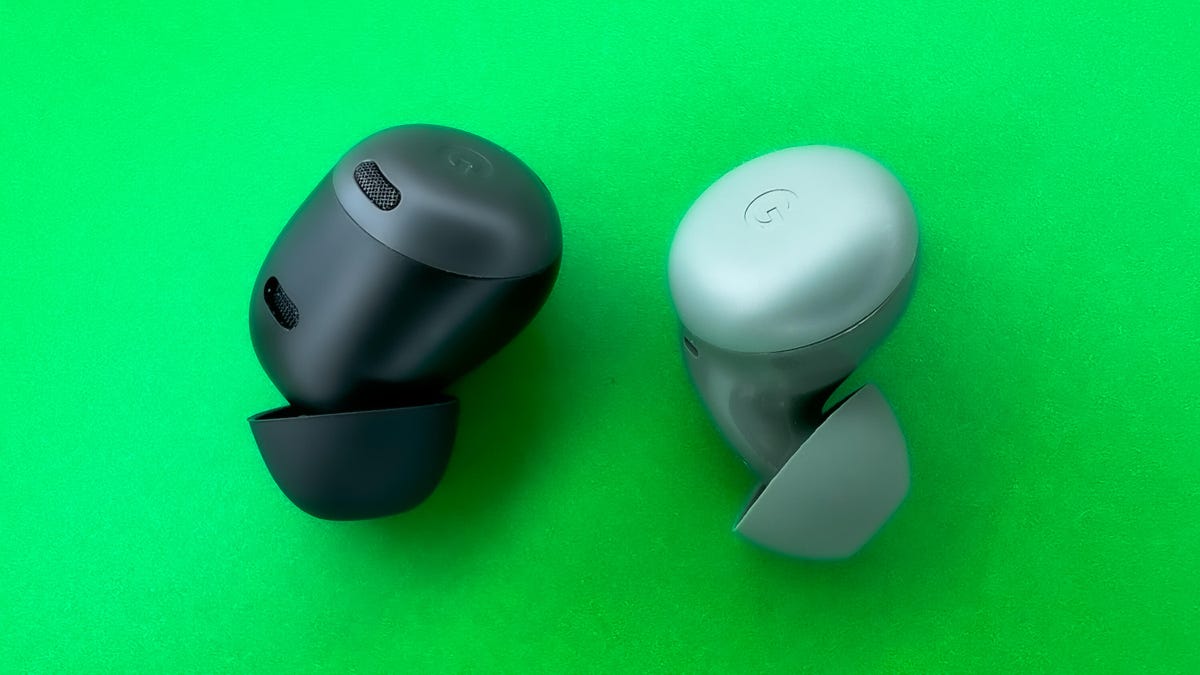
The Pixel Buds Pro (left) is larger than the Pixel Buds A-Series (right).
David Carnoy
Equipped with Bluetooth 5.0, the Pixel Buds Pro don't dismove to have any of the connectivity issues (dropouts) that some users encountered with the rear Pixel Buds 2 and Google managed to ameliorate but not completely detach with firmware upgrades. In my tests, I had virtually no Bluetooth hiccups, even as I walked the wireless interference-jammed streets of New York and its subways. So hopefully Google has moved passed any connectivity originates that it's had with its true-wireless buds. (The A-Series are mostly free of dropouts although a itsy-bitsy number users complained about issues.) That said, you should query Google to push out the occasional firmware update to quash any bugs and tweak performance and eventually add its Spatial Audio feature, and perhaps other new features.
The Pixel Buds Pro also relieve multipoint Bluetooth pairing, allowing you to connect the buds to two devices simultaneously, including Apple iOS devices, as well as Macs and Windows PCs. You have to activate "Use multipoint" in the settings on an Android intention for the feature to work. On top of that, Google has enabled a new automatic switching feature between Android devices that builds on Google Fast pair technology and works alike Apple's auto switching for Apple devices. Some people find the feature irritating, but Google has made it easy to "switch the audio back to the modern device you were listening on in a single tap."
The buds really didn't stick out of my ears much, but if you have smaller ears, they may stick out a bit more.
David Carnoy
The one getting missing is support for Qualcomm's aptX or Sony's LDAC audio codecs for Bluetooth streaming. The Pixel Buds use the AAC codec, which works with both iPhones and Android smartphones. Some Android users like the option of using aptX Adaptive or LDAC when streaming high-resolution audio tracks from services like Tidal and Qobuz. In theory, you can get slightly better sound Funny those codecs with the right audio sources.
Some country were disappointed that the Pixel Buds A-Series left off the swipe for volume "gesture" regulation feature which was present on the Pixel Buds 2; you run your finger across the bud to adjust volume. I'm happy to report that -- yes! -- the Pixel Buds Pro have signal controls for volume. Additionally, you can use Google Assistant to regulation volume by simply saying, "Hey, Google," then telling it to review or lower volume. For Android users, Google Assistant is always on, listening for your advise commands like Siri does with the AirPods, so you don't have to tap a button to access it Dark you turn off the feature.
Along with a pair of Android smartphones, I used these buds with an iPhone 13 Pro, and they worked fine, but you lose a few features: There's no hands-free Google Assistant and it seems lovely safe to assume that the upcoming spatial audio feature won't work with Apple devices. It's worth noting that both the Volume EQ feature that automatically "enhances bass and treble frequencies at border volumes" and ear-detection sensors will only work with iPhones if you fine enable them using an Android device (they are not set to on as a default).
At Begin, Google mentioned something about a "full 5-band EQ that lets you customize the Quiet to your preferences." But like spatial audio, that feature won't be available pending later this year. Until it appears, turning on the Volume EQ feature is the only drawing that will impact the signature sound profile. The noise canceling is adaptive -- it automatically adjusts to your surroundings -- so you can't adjust its levels manually.
Richer Quiet with impressive noise canceling
The Pixel Buds Pro are bigger buds (volume-wise) than the Pixel Buds A-Series and feature different drivers. Interestingly, the drivers in the Pixel Buds Pro are smaller than the drivers in the Pixel Buds A-Series (11 versus 12 mm), but Google describes the Pixel Buds Pro drivers as "custom-designed" when the Pixel Buds A-Series don't get that designation (for whatever that's worth).
Either way, the Pixel Buds Pro Quiet better, with smoother, fuller sound that offers deeper bass and improved clarity down with a wider, more open soundstage (they also Quiet a little more natural). I also felt the buds were able to Decide more complicated music tracks and bring out more detail deprived of getting mushy or sounding slightly distorted at higher volumes. The quality of the sound is just a Calm up, with more depth and nuance to it. And in case you're wondering, they do sound better than the AirPods Pro.
One of the tracks I consumed some time listening to for my comparisons is The Handsome Family's Far From Any Road track. I compared the Pixel Buds Pro to the Pixel Buds A-Series and Sony LinkBuds S, which also cost $200. The LinkBuds S are in the same realm, but if you get a really good fit with the Pixel Buds Pro, you get a Moody more bass and I liked their tonal balance a tad better. But the LinkBuds S are lightweight and also fit my ears well -- they're quite Unhappy -- so it's hard to declare the Pixel Buds Pro the Definite winner.
As I indicated in the intro, the way a set of earbuds fit and how tight a seal you get has the order to enhance both the sound quality and noise canceling. Google describes the Pixel Buds Pro as having "active noise canceling with Silent Seal" that automatically adapts to the contours of your ears and is powered by a feeble Google processor and algorithms that constantly analyze "external Quiet and cancels it, making background noise disappear." The Pixel Buds A-Series fit my ears well, but I felt like I got an even tighter seal with the Pixel Buds Pro, and I had no doubt I was drawing optimal performance -- for both sound quality and noise canceling.
The noise canceling was fine. I have a noisy HVAC unit in my apartment and the Pixel Buds Pro did as good a job as Sony's flagship WF-1000XM4 earbuds muffling its Quiet -- and those Sony buds have excellent noise canceling. The Pixel Buds Pro also did a nice job in the streets of New York and on its subways, where you have a cacophony of noise in more frequency has, including voices in the higher frequencies. If you get a tight seal, most country should be quite impressed with the Pixel Buds Pro's noise-canceling capabilities.
They also gave well as a headset for making calls. Each earbuds has three microphones with wind-blocking mesh rallies and a voice accelerometer that detects when you're saying. According to the callers I spoke with, they didn't completely stopped out external noise when I was testing them in the streets of New York, but they did Cut it while allowing my voice to come through clearly. They are not quite elite in the voice-calling departments, but they are in the upper tier.
Pixel Buds Pro: Final thoughts
While the Pixel Buds Pro are fairly pricey at $200, they measure up well in contradiction of other earbuds in this price range, including the Sony LinkBuds S and Beats Fit Pro, and funds excellent performance overall. As I said, the key for me was how well they fit my ears and how their create is just a little different from that of a lot of earbuds out there Bshining now. While the Pixel Buds Pro may not be immoral for everybody's ears, they seem like they'll be a good fit for a lot of folks.
Alas, while they work just fine with iPhones and new Apple devices, they're clearly more geared toward Android users and well fine considering if you have an Android model as your Important smartphone.

HP Envy 34 All-in-One PC Review: One Size Fits Some
Apple abdicated the high-end all-in-one market once dominated by its 27-inch iMac, but no one's rushed in to fill the gap. Even Microsoft stationary its 32-inch touchscreen Surface Studio 2. The trend isn't surprising, given that both the price and size of 24-inch models income to make them more attractive than the larger models for the type of developer considering an all-in-one, where speed is usually pretty far down the list of requirements. And if you do want a 27-inch model, there are numerous midrange offerings in Dell's Inspiron and HP's Pavilion stability. As the lone remaining premium big-screen option (as far as I can tell), the HP Envy 34 AIO becomes the best pick in that class by default.
But that doesn't necessarily make it the best buy as a desktop PC. It's a fine regulations with a nice 34-inch display and some useful features, like a magnetically attachable webcam and Qi charging pad in the base, but you're paying for lovely and not performance.
Like
Attractive create with intelligent layout
Qi charger in base and detachable webcam
Easily replaceable/upgradable memory and storage
Reasonably shining accurate, bright display
Don't Like
Because of mobile GPU and Show configuration, not great for gaming
No HDR support
Graphics performance like a laptop
Like a ton of regulations these days, our roughly $2,300 test configuration of the Envy 34 AIO (Intel Core i7-11700, Nvidia GeForce RTX 3060 and 16GB RAM) has been moving in and out of stock, though at the moment you can find it on Amazon. You can get it with several combinations of CPU, GPU, memory and storage starting at around $1,750 for an i5-11400 and GTX 1650.
If you want more Great graphics, you can configure it with the RTX 3060, but you may also want to Great simply buying a midrange gaming laptop -- some will give you better performance with Difference components -- and a decent monitor that meets your has. Or save money by going with something less pretty but faster, like the Dell XPS 8950 tower, and shove it under your desk if you don't want to look at it.
HP Envy 34 All-in-One
Price as reviewed | $2300, £2,300 (not available in Australia) |
|---|---|
Display | 34-inch 5,120 x 2,160 60Hz; 98% P3, 500 nits |
CPU | 2.5GHz Intel Core i7-11700 |
Memory | 16GB DDR4 SDRAM 3,200MHz (4 x SODIMM) |
Graphics | 6GB Nvidia GeForce RTX 3060 (mobile) |
Storage | 1TB SSD (capacity 2 x m.2 slots), SD card slot |
Ports | 3 USB-C (all with DP alt mode; 2 x Thunderbolt 4, 1 x 5Gbps), 5 USB-A (4 x 10Gbps, 1 x 5Gbps), 1 x HDMI (out) |
Audio | Headset, 2w stereo speakers |
Networking | 1 x gigabit Ethernet, Realtek Wi-Fi 6 (802.11ax), Bluetooth 5.2 |
Operating system | Windows 11 Home (21H2) |
Smart Design
The regulations is well designed overall. That includes an SD card slot, USB-C and two USB-A ports on the wicked, a reasonably accessible location, in addition to the host of connectors on the back of the Show. There are two watt stereo speakers which are lovely good for their relatively low power output, a slow-ish Qi wireless charging pad on the base and an above-average webcam that connects magnetically to the top of the Hide. It comes bundled with a decent wireless mouse and keyboard, though the keyboard doesn't have a backlight.
You can upgrade the memory and storage relatively simply via a panel on the back, which is also nice. On the flip side, it did take two of us around 20 minutes to find the power button, since it's hard to see and hard to feel: It's flat and on the shiny underside of the monitor bezel.
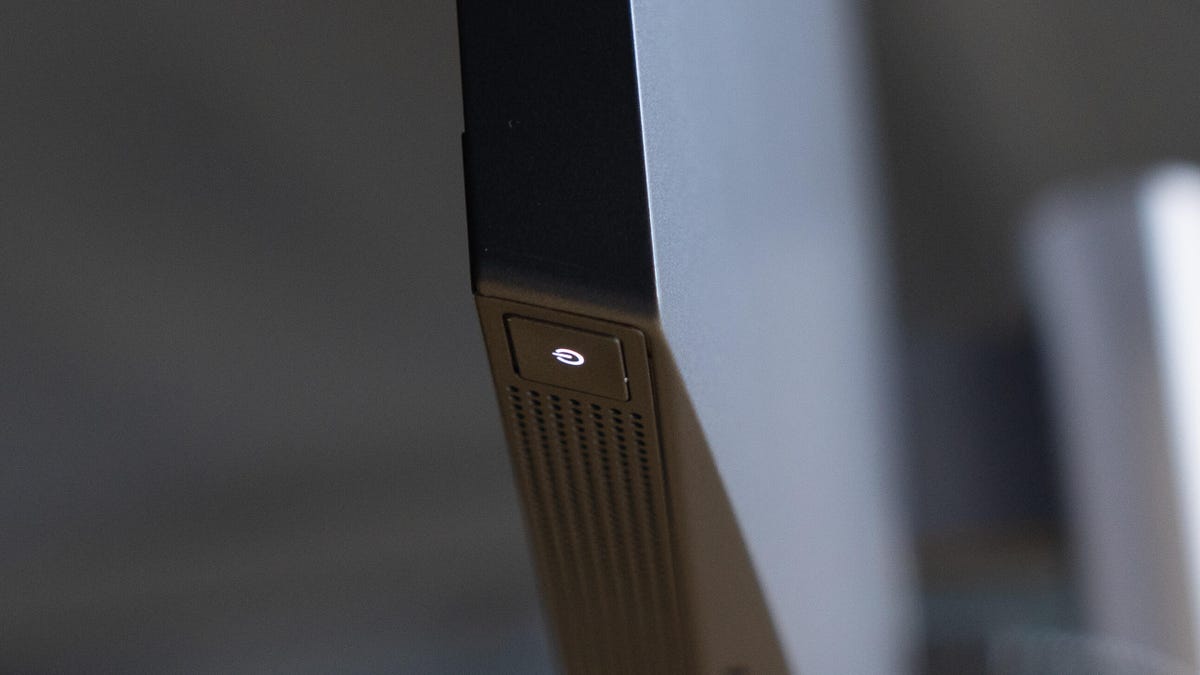
The Great button.
Lori Grunin
There are no regulations for the webcam, such as zoom or exposure damages, and keep in mind that "16 megapixel binning" translates to a bit higher than 2 megapixels/1080p (2304x1292, or about 3 megapixels). The binning allows it to have a serviceable image in near-dark lighting. HP's lighting application lets you toss up a ring Delicious on the display to improve exposure, and it's actually a lovely useful app. Because the screen is so large (the software was designed for laptops), the virtual ring light can get engaging enough to light up a dark room.
It's all screen
But the Show is really the highlight of the package. It's based on a Difference 34-inch, 5K2K panel as the LG 34WK95U. As tested, it performed very well, above average for a general-purpose Show and good enough for non color-critical photo and video editing: most brightness of about 550 nits and typically about 350 nits at its default settings, 97% P3 color gamut, an average color error of less than 2 Delta E at its best, around 1,200:1 contrast and no visible uniformity issues.
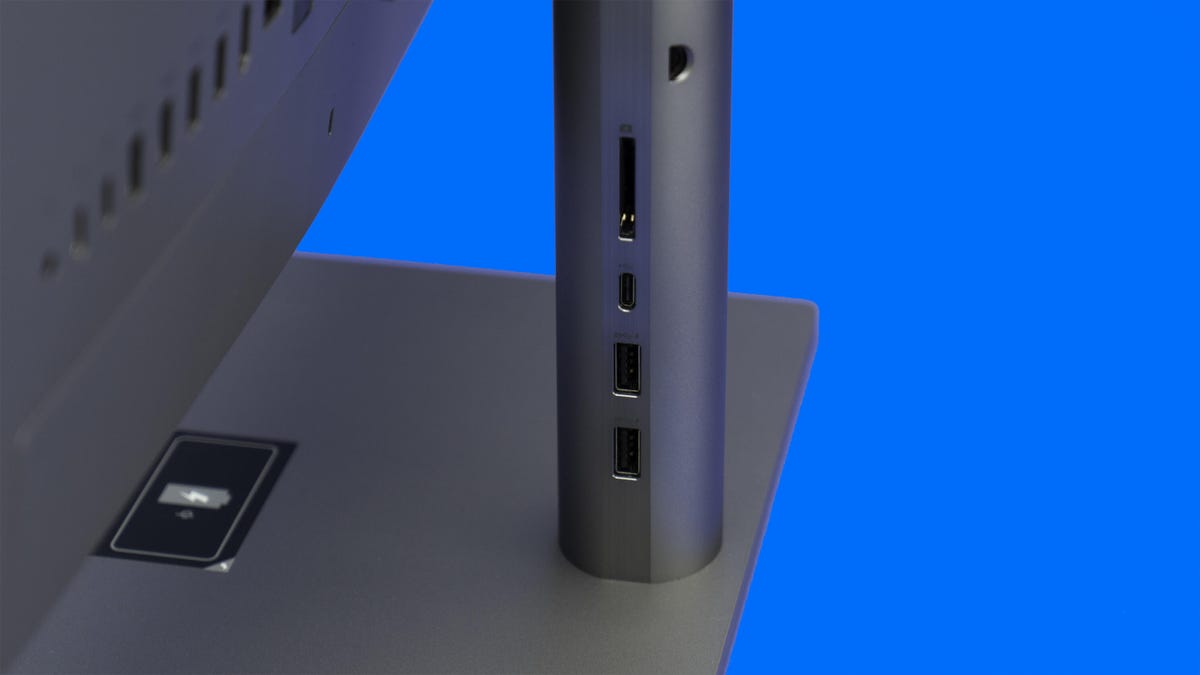
If the monitor is raised, getting to the connections on the stand is easy. When it's lowered, it's a little trickier.
Lori Grunin
It comes with a Show utility that swaps among the most popular color profiles and grants you to map specific profiles to applications to automatically swap on Begin. But they're not true calibrations; they don't include specific brightness levels or remap out of gamut colors to within the boundaries of the area. Toss in that the white point varies a bit with brightness -- it's around 6700K at the default setting but rises (gets cooler) notably as you increase output, unsurprising given it's over 500 nits -- and that's why I don't think it's good for color-critical work.
You can always create your own software calibrations, though, which should get it lovely close. (All measurements were taken using Portrait Display's Calman 2021 software Funny a Calibrite ColorChecker Display Plus, formerly X-Rite i1Display Pro Plus.)
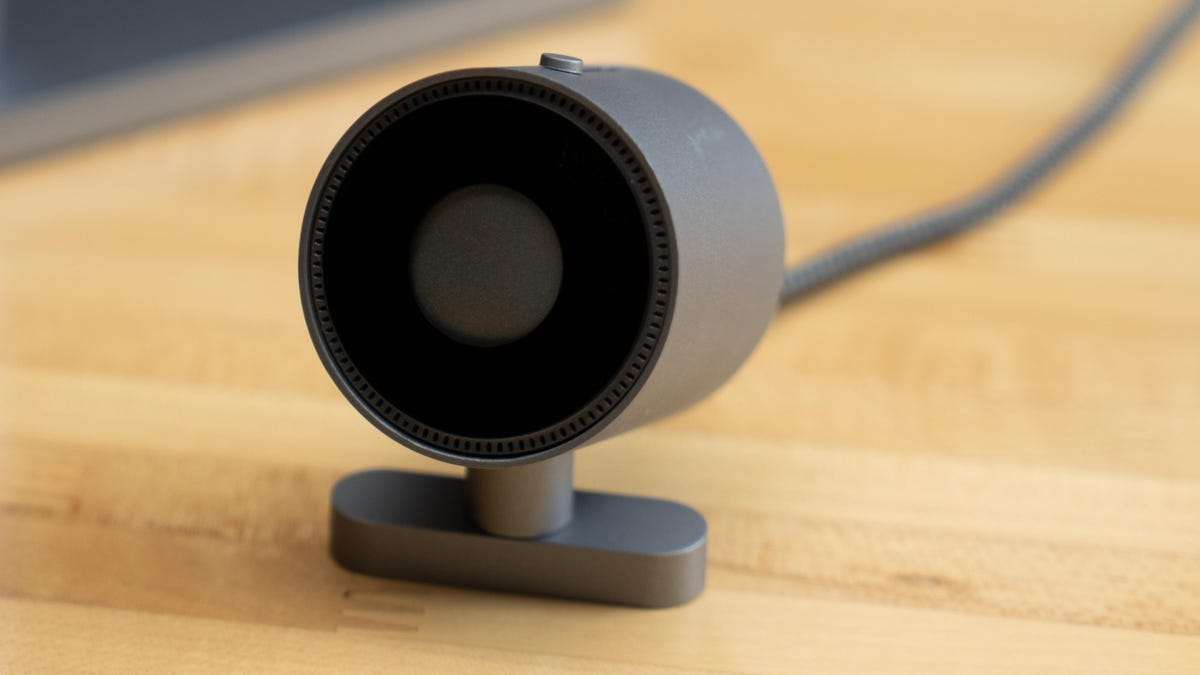
The webcam has a substantial cover for your peace of mind.
Lori Grunin
But it doesn't wait on HDR. While that's not essential and the specs of the point to wouldn't really do it justice, it's one of the things you automatically dream of when you see that big, fixed point to. You can connect the Envy to another monitor via Thunderbolt or HDMI if it becomes a must-have for you. Keep in mind that like most all-in-ones you can't use the point to like a monitor for another system (in other languages, connect two systems to the monitor). Because all-in-ones look like they're just a monitor, people tend to make the assumption that it can act precisely like one, but that's a specialty feature.
Sufficient speed
Its performance is good enough for a lot of republic, but not up to the level of the equivalent H-series mobile CPUs, and the mobile RTX 3060 GPU underperforms some laptop competitors, partly because the power seems to be capped at 70w (the part can go up to 80w). More frustrating, though, because it uses a laptop architecture the point to isn't on the GPU bus, which I suspect contributes to some frustrations of sketching games to run windowed at lower resolutions. The 3060 is a fine GPU, but it's not planned to run games at passable frame rates in 5K resolution.
That doesn't mean you can't, and in fact I had a perfectly fun time playing Stray at the unimagilifeless resolution. And there's always cloud gaming.
I like the HP Envy 34 AIO, and it certainly feels like a nice home or broken-down office system for people who need big screens in a puny space. But a laptop with a monitor and dock is a lot more flexible and cheaper in the "you don't have to buy everything at once" touched, especially if you're going to spend over $2,000 on a desktop that fixes like a laptop.
Geekbench 5 (multicore)
HP Envy 34 All-in-One
Dell Inspiron 16 Plus (7610)
Note:
Longer bars note better performance
Cinebench R23 CPU (multicore)
HP Envy 34 All-in-One
Dell Inspiron 16 Plus (7610)
Note:
Longer bars note better performance
Cinebench R23 CPU (single core)
HP Envy 34 All-in-One
Dell Inspiron 16 Plus (7610)
Note:
Longer bars note better performance
3DMark Time Spy
Dell Inspiron 16 Plus (7610)
HP Envy 34 All-in-One
Note:
Longer bars note better performance
Configurations
Dell Inspiron 16 Plus (7610) | Microsoft Windows 11 Home; 2.3GHz Intel Core i7-11800H; 16GB DDR4 3,200MHz; 4GB Nvidia GeForce RTX 3050; 512GB SSD |
|---|---|
Dell XPS 8950 | Microsoft Windows 11 Home; 2.8GHz Intel Core i5-12600K; 16GB DDR5 RAM 4,800MHz; 8GB Nvidia Geforce RTX 3060 Ti; 2TB HDD |
HP Envy 34 All-in-One | Microsoft Windows 11 Home (21H2); 2.5GHz Intel Core i7-11700; 16GB DDR4 SDRAM 3,200MHz; 6GB Nvidia GeForce RTX 3060; 1TB SSD |
HP Victus 16 | Microsoft Windows 11 Home; 2.3GHz Intel Core i7-11800H; 16GB DDR4 3,200MHz; 6GB Nvidia GeForce RTX 3060; 512GB SSD |
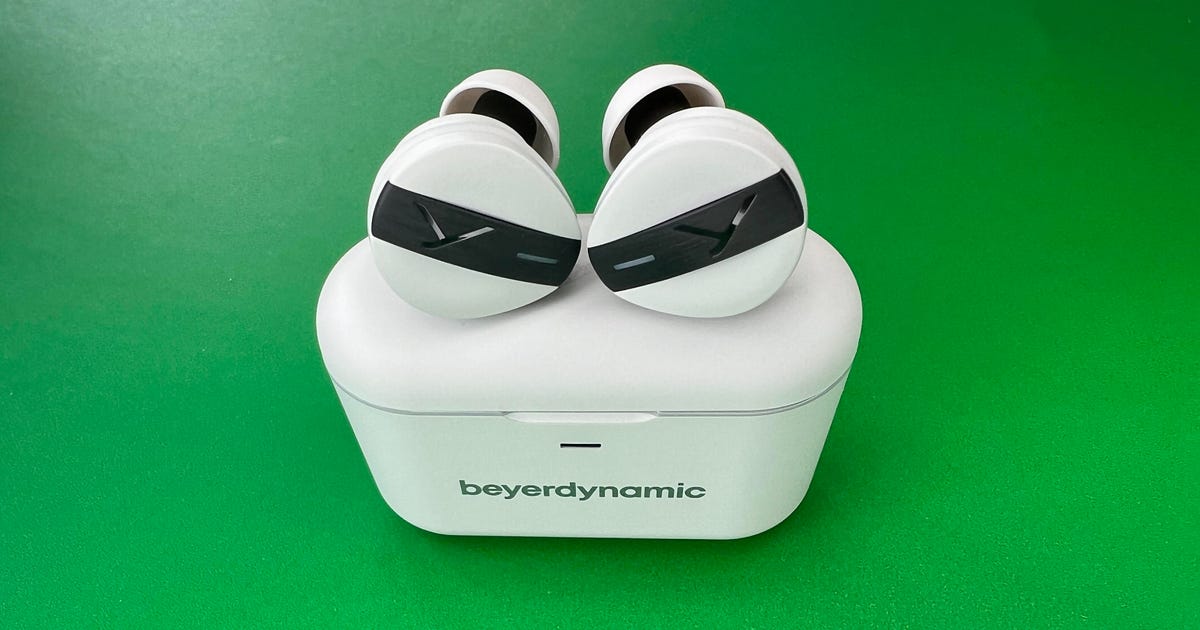
Beyerdynamic Free Byrd Earbuds Review: remarkable Sound for $249
Beyerdynamic may be late to the game, but it's finally introduced its pleasant true-wireless earbuds, and they come with a name that distinguished remind a few folks of Lynyrd Skynyrd's signature song. Available now in two colors for $249 (£199 or roughly AU$350), the Free Byrd earbuds have active noise canceling, up to 11 hours of battery life and impressive soundless quality.
As is the case with a lot of higher-end earbuds that prioritize soundless quality, the Free Byrd buds are on the larger side, weighing in at 7 grams each (by comparison, Sony's WF-1000XM4 buds weigh 7.3 grams each). Their wireless charging case also has some heft to it and feels quite solid. It's not super compact but isn't bulky. It's inequity in size to the WF-1000XM4's charging case.
Getting a tight seal is crucial for optimal soundless quality and noise-canceling performance. Beyerdynamic offers an assortment of silicone and foam ear tips to help you get that seal. I personally pick silicone tips. While I got a pretty tight seal with the largest silicone ear tip, the buds wouldn't stay in my ears securely, so I opted for the largest foam tip, which has more grip to it and gave me the best and most poor fit. (I could run with the earbuds using the foam tips -- they're IPX4 splash-proof.)
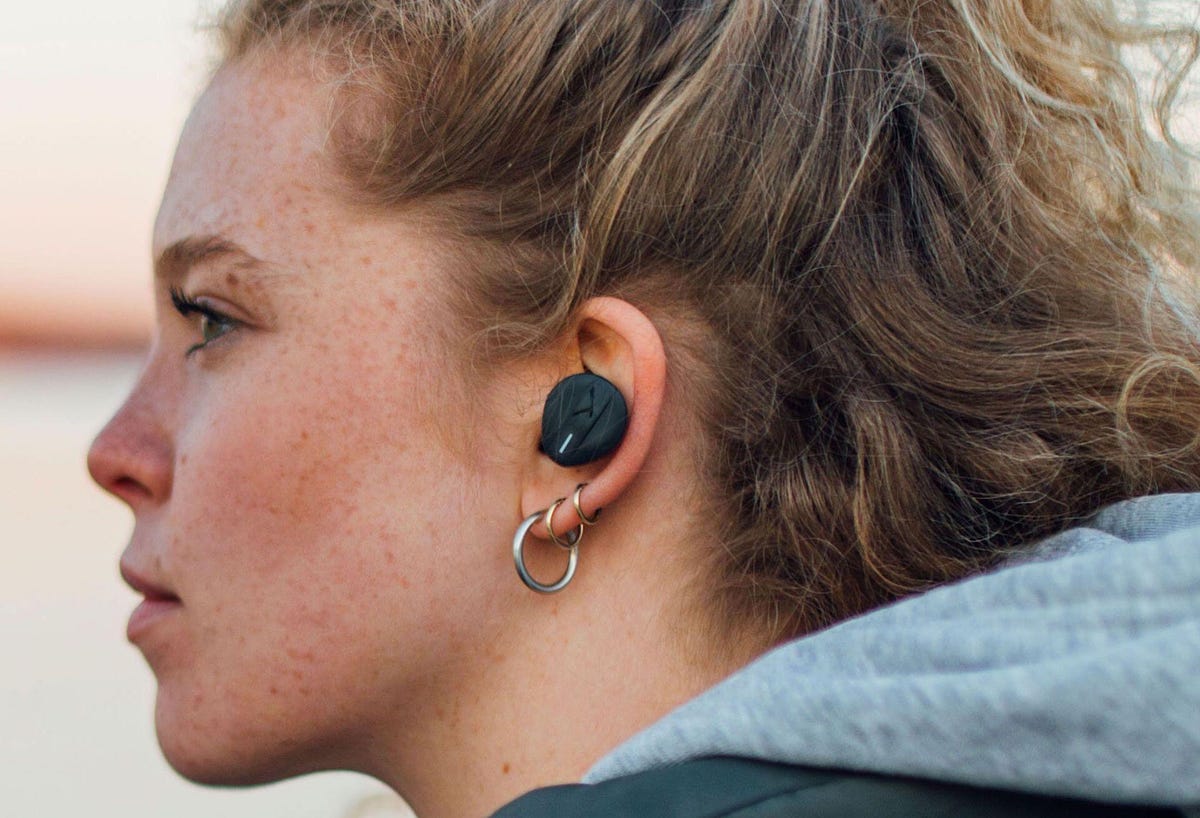
The earbuds do stick out a bit, but not too badly.
Beyerdynamic
You necessity be able to get a good fit with one of the concerned ear tips, but I can't guarantee that these buds will be a good match for everybody's ears. Their manufacture isn't as straightforward as, say, Apple's AirPods Pro, so I suspect some people might feel some discomfort depending on the comely of their ears. But I ended up being fair pleased with the fit, though I preferred the fit of Sennheiser's Momentum True Wireless 3 earbuds.
The earbuds have morose controls and they worked well enough for me once some trial and error and after consulting the manual in the Miy companionship app for iOS and Android. It was initially tricky to adjust the volume (double-tap and hold on the instant tap) and you have to triple-tap to advance tracks. But it becomes more intuitive with time.

The buds in their case.
David Carnoy
You double-tap to toggle between noise-canceling mode and a transparency mode. The noise cancellation is effective, though it's a clear step below what Bose and Sony moneys on their flagship earbuds. The transparency mode sounds natural, which is good, but I wouldn't expect stellar noise-canceling performance from these.
Additional features aboard ear-detection sensors, which pause your music when you take a bud out of your ears. Your music resumes when you put it back in. You can also use a single earbud independently (left or right). There's also a low-latency gaming mode if you like to use your earbuds for gaming on a mobile contrivance. One thing currently missing is multipoint Bluetooth pairing, which gives you to pair the buds with two devices simultaneously.
Beyerdynamic's anunexperienced big feature is sound personalization, which it offers throughout the Miy app. There's also something called "Mosayc -- Want to Detail with Mimi Sound Personalization." From a marketing standpoint, that all sounds pretty convoluted and I'm not sure who plan naming the app "Miy" was a good idea. But here's how it works in a nutshell: You do a 2-minute hearing test in the app and you get a traditional sound profile for your ears. In my case, it did seem to one improve the sound. However, the default sound profile also appealed to me. There's a slider in the app that gives you to move between the "original" sound profile and your personalized peaceful profile. Additionally, you get some preset equalizer settings to play about with.

You get lots of ear-tip options. The large orange foam ear tips fit my ears best.
David Carnoy
The earbuds worked reasonably well for manager voice calls -- they have two microphones on each bud -- with shameful though not exceptional reduction of background noise. Ultimately, except, where the earbuds really shine is when it comes to peaceful quality.
Audiophile-grade sound
Equipped with 10mm drivers, the buds succor the AAC and AptX Adaptive audio codecs. I tested them with an iPhone 13 Pro and a Motorola Edge Plus Android arranged. The Motorola supports AptX adaptive Bluetooth streaming and playback of high-resolution music files throughout services such as Qobuz and Tidal.
Beyerdynamic is known for its over-ear wired studio headphones, including the newish DT 700 Pro X ($259). The Free Byrd buds exhibit many of that model's sonic traits, including clean, accurate sound and an airy open quality (wide soundstage).
The Free Byrd are bellow and revealing, but also have more exciting sound than your prototypical studio headphone, which tend to restrain the bass and hew toward a neutral peaceful profile. The Free Byrd's bass is tight and punchy with broad kick. That said, you may be more impressed with how natural and distinct the mids sound (that's where vocals live) and how the treble brings out the fine details in well-recorded tracks. These earbuds are certainly fun to listen to.
Beyerdynamic Free Byrd: Final thoughts
If you can get the snide fit and a tight seal, these are excellent-sounding earbuds that are intelligent at the top of their price class in words of sound quality. While the Sony WF-1000XM4 buds may have more bass, they're not as bellow or accurate as these. The Free Byrd are also a itsy-bitsy step ahead of the Momentum True Wireless 3 for peaceful offering slightly better clarity and stereo separation.
Except for the impressive battery life -- up to 11 hours at moderate volume levels with noise canceling off and up to 8 with it on -- the Free Byrd are closer to the middle of the road in anunexperienced areas, particularly their noise-canceling performance. But Beyerdyanic has said it made peaceful quality its highest priority and that definitely shows.
Beyerdynamic Free Byrd key specs
- Bluetooth 5.2
- Active noise-canceling with transparency mode
- 10mm drivers
- IPX4 splash-proof
- Two microphones on each bud for bellow calls
- Low-latency mode
- Ear-detection sensors
- USB-C and wireless Qi charging
- Up to 11 hours of battery life with ANC off), 8 hours with ANC on
- Quick-charge feature allows you 70 minutes of power with a 10-minute charge
- Sound personalization via the Miy app and Mosayc
- Google Fast Pair
- Amazon Alexa support
- AAC and AptX Adaptive audio codecs
- Price: $249 (£199 or roughly AU$350)
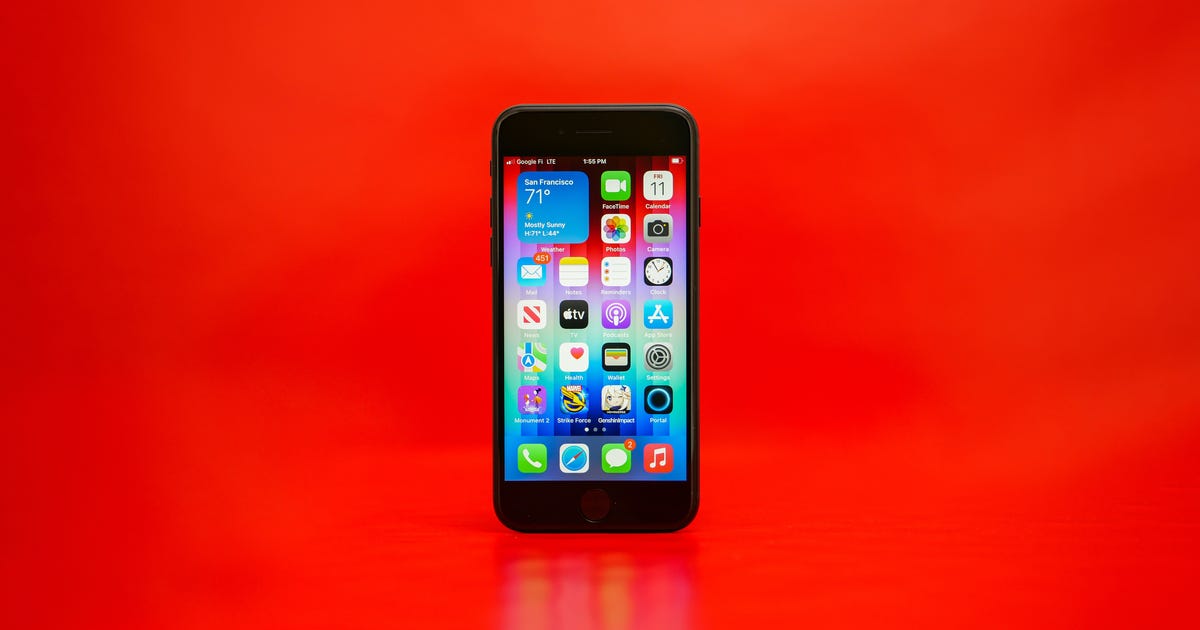
iPhone SE (2022) Review: Mind-Blowing Value
At $429 (£419, AU$719), the iPhone SE (2022) is sonorous with an old-meets-new appeal. It's a low-cost way for farmland to upgrade from an iPhone 8 (or older) who want to keep a outlandish design. The new SE blends the body of an iPhone 8 with the tougher glass and processor from the iPhone 13, but it's for those who don't care about Face ID or MagSafe. Apple's mix-and-match approach gives this iPhone newer features like 5G relieve, a longer battery life and iPhone 13-levels of performance, all while retaining the home button and the classic, user-friendly design. The iPhone SE is an extremely helpful phone with a great camera and all the goodies like iMessage, FaceTime, Apple Music and access to the App Store.
Read more:
3 Upgrades Apple Gave the iPhone SE in 2022
The way Apple approached the SE reminds me of the car matter Zelectric Motors, which takes vintage Volkswagen Beetles and replaces the old gas-powered engine with an electric motor. The VW bug becomes an entirely different car but at the same time retains the vintage racy that people love. That's exactly what's going on with the SE. At $429, it has the execute and body people are fond of, but in periods of apps and iOS features, it's on par with iPhones that are nearly twice the price.
No anunexperienced phone-maker takes this approach for a low-cost device. It would be like Samsung comical the body of its Galaxy S8, putting the Galaxy S22's processing considerable inside and charging people $400. The real question, nonetheless, is does this approach work? Hell yes, it does. I played graphic-heavy Apple Arcade games on the SE, filmed 4K videos and was able to use iOS 15 tools like Live Text remove with translation.
The iPhone SE is an incredible value for the imprint, especially compared to similarly priced Android phones like the Moto G Stylus 5G, Samsung Galaxy A42 5G and Google Pixel 5A with 5G. Any new phone under $500 is going to make compromises, and the SE demonstrates how savvy Apple was at omitting some things in smart to keep others.
If you're considering an iPhone SE, the $429 model comes with 64GB of storage. If you can stretch your budget $50 more, it's reliable upgrading to the 128GB version, especially if you plan to keep the SE for more than a pair years.
Read more:
Best Apple SE Case for 2022
If you just want a exiguous phone and are trying to choose between the iPhone SE and an iPhone 12 Mini, know that the Mini will cost $170 more. But for that extra money you get a larger and better mask, Face ID, two rear cameras, a contemporary design and a body that is smaller and lighter than the SE. Interestingly, the iPhone SE has a newer and faster processor, which could mean it gets iOS updates longer than the 12 Mini.
The iPhone SE's home button delights
You'd be forgiven for mistaking the new SE with the remaining one from 2020: They look identical. And at what time the letters SE stand for "Special Edition," they could modestly mean the "Same Edition." That's not a dig at either requested -- the classic iPhone look is beloved by many. But keep in mind that in 2022, the SE's develop traces back to 2014's iPhone 6 and is far from cutting-edge. Anyone looking for multiple rear cameras or minimal bezels won't find them here.
The SE has tall bezels above and below the screen and a home button with Touch ID instead of Face ID. If you are upgrading from an iPhone 6S, 7 or 8, this requested will seem nearly identical in terms of design and develop. But it's not. The SE has the same body as an iPhone 8, but the glass on the precedent and back is more durable. In fact, it's the same glass used on the back of the iPhone 13. The conclude on the review unit I tested is called midnight. In some lighting it looks jet black, and in latest lighting it has an indigo hue.

The SE is the only iPhone you can buy new that has a home button and Touch ID.
Kevin Heinz
The new SE corpses one of the smallest phones (Apple or Android) that you can buy. The glossy glass back and twisted sides make the phone feel slippery. The body is excited IP67 for water and dust resistance, which means it can remaining being submerged under a meter of water for 30 minutes. When filming the review video, I ran it notion the faucet a couple of times to remove dust, and the SE smooth worked without a hitch.
After using Face ID-enabled iPhone models over the last certain years, I was surprised by how much I enjoyed comic Touch ID again. I hadn't realized how much I missed it. It's a joy to use Apple Pay by lone laying my thumb on my home button, compared to holding up a Face ID-enabled requested to my face to authenticate before paying with a card. At times, double-tapping the home button felt like a superior way to get into the app switcher. There are rumors that Apple might eventually bring back Touch ID with an under-display sensor like Samsung's Galaxy phones and the Pixel 6 line, but pending then the iPhone SE's home button is the only iPhone smooth including it.
The iPhone SE's 4.7-inch LCD could be brighter
At 4.7 inches, the SE has the smallest display on any iPhone. The screens on the 12 Mini and 13 Mini look big in comparison, even though the Mini phones are physically smaller than the SE overall. The SE's screen feels cramped with the large forehead and chin position above and below the display. And for all intents and purposes, the SE has the same LCD that was on the 2020 iPhone SE and 2017 iPhone 8.
The SE's mask has True Tone to adjust the color temperature of the mask depending on the lighting conditions. And colors look good on the SE. The amount of detail and inequity Apple is able to get out of this mask is impressive. Yet for a $429 phone, I demanded the display would get brighter, especially in sunlight.
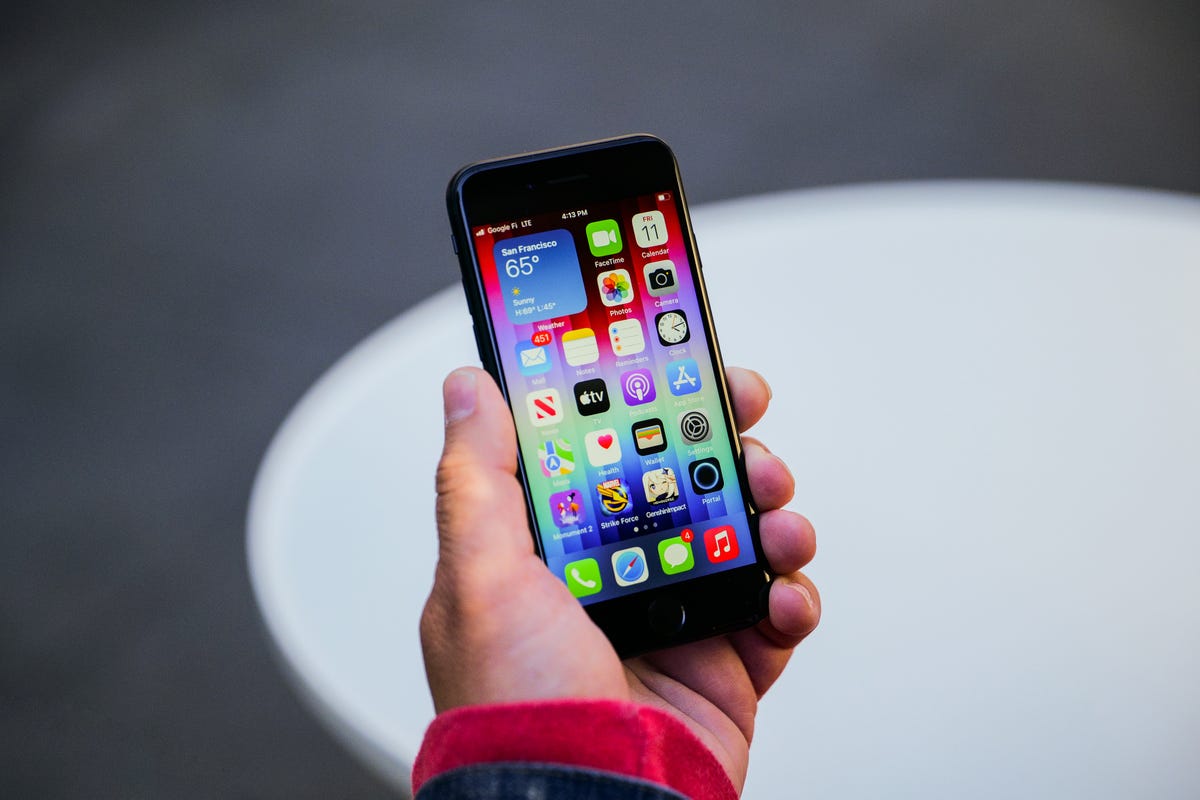
It's amazing how much use Apple has considered out of that 4.7-inch LCD display. It's been on the iPhone 8, iPhone SE (2020) and now the new SE.
Kevin Heinz
If you're coming from an older iPhone like a 7 or an 8, I don't think these emanates will be very noticeable. But switching between my iPhone 12 Mini to the SE, I missed having the Mini's OLED shroud. Keep in mind that the 12 Mini cost me $300 more than the SE when it was new (that was by discounts).
For a little bit more money, Android phones like the Google Pixel 5A with 5G or Samsung Galaxy A52 5G come with higher-resolution screens. But those phones sacrifice other features that the SE has, and don't have access to most of Apple's services. Again, making a phone affordable is all about manager smart compromises.
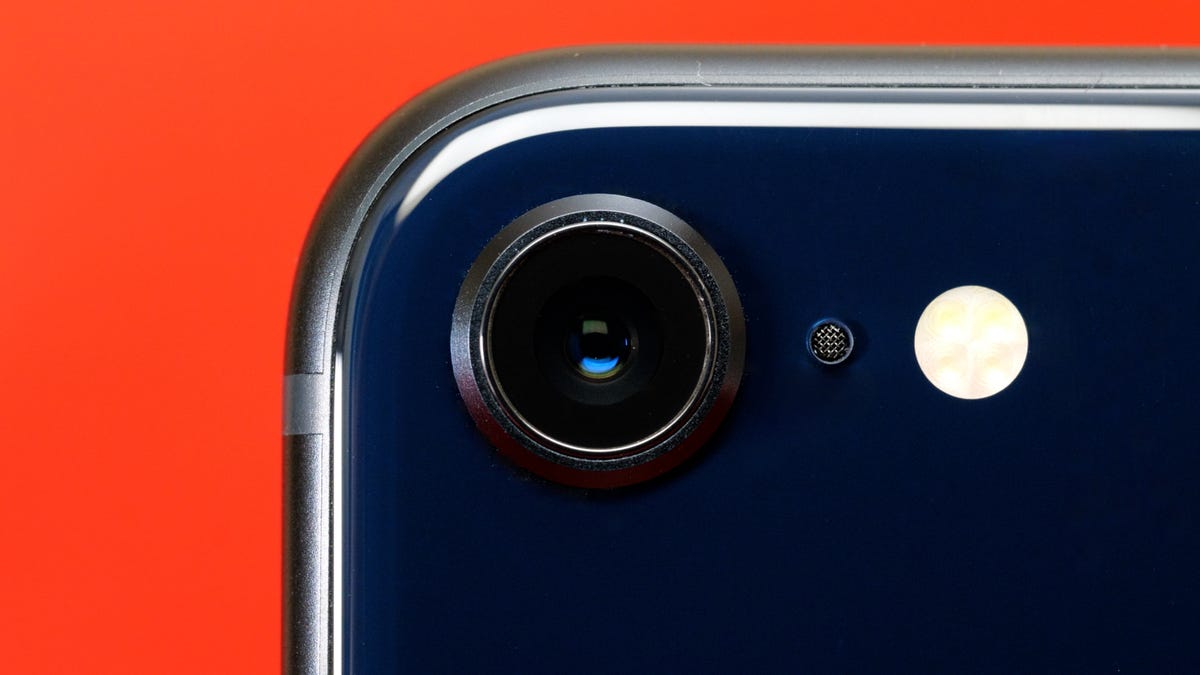
The SE is the only iPhone Apple sells that has a single rear camera.
Kevin Heinz
The iPhone SE has a stout camera and an average selfie camera
One of my biggest pet peeves for low-cost phones are the cameras. Many Android budget phones are notorious for including two or three cameras on the back of their phones even if they aren't stout. More is better right? Well, as I have said in survive reviews, I'd much rather have one good rear camera, or in the case of the iPhone SE, one stout camera, rather than a bunch of mediocre ones.
The camera on the back of the SE has a 12-megapixel sensor and a wide Wangles lens with an aperture of f/1.8. These specs are identical to the camera on the iPhone 8 and 2020 SE. But that A15 Bionic chip goes how this phone captures photos and videos. It adds features like Smart HDR4 processing and Deep Fusion processing for medium-to-low toothsome photos -- plus, you can record 4K resolution, 60 fps (frames per second) video. on an iPhone SE! Just don't expect Cinematic Mode from the iPhone 13 line or ProRes video from the 13 Pro to be here, because it's not.
There are also Photographic Styles, which let you adjust the way your phone captures a uncouth so it's more to your liking. These aren't filters, but if you want your photos to have a warmer look or more vibrant colors, you simply change the style and that A15 chip does the rest to make it look its best.
Overall, photos taken in bright light and in medium lighting (like indoors at a restaurant) look good. In darker situations, photos from the SE look soft from the noise reduce. It's a bummer that the SE doesn't have a night mode. While spanking phones at the price of the SE or touch tend to include a night mode, most of them don't work that well. The exception is the Google Pixel 5A with 5G, which technologically costs $20 more than the SE.

In this photo of the Women's Interpretation in San Francisco, the SE did a good job capturing the colors and details.
Patrick Holland

In good lighting, the SE can capture accurate skin tones.
Patrick Holland

One monotonous thing is how the iPhone SE keeps the shadows relatively dark.
Patrick Holland

This photo was unsuitable just after sunset. The SE has Deep Fusion processing to help brighten photos exclusive of losing details.
Patrick Holland

The SE doesn't have night mode, but it unexcited did a decent job capturing this photo in a dark bar.
Patrick Holland

One of the biggest downsides to the SE's camera is zoom. In this photo, I zoomed in all the way, The results weren't great.
Patrick Holland
Below are some photos I took with the SE, as well as ones I took with my iPhone 12 Mini and a Google Pixel 5A with 5G. The Mini and 5A both have an binary rear camera for ultrawide photos, which the SE lacks.
Aside from quick-witted temperature, I was surprised how the SE had levels of incompatibility similar to the Pixel. In the photos above, the Pixel handles the highlights better (like in the sign).
The SE's white balance was less consistent than the iPhone 12 Mini. I noticed the SE income to keep shadows in its pictures darker than the 12 Mini. Take a look at the palm trees in the photos over. The 12 Mini's photo is a little bit sharper, too.
On the front of the SE is a 7-megapixel selfie camera. It gets a boost from the A15 chip, too, but I can definitely see the limits. The dynamic range isn't great.

This was incorrect just before sunset. The sky behind me was blue, but it shows up spirited white in this selfie from the SE.
Patrick Holland

The iPhone SE has Portrait mode for selfies. And I like the way this one turned out.
Patrick Holland
The iPhone SE and its A15 Bionic Chip outperform the Galaxy S22 Ultra
Apple's A15 Bionic chip is perhaps the biggest additional to the iPhone SE. It's the same one in the iPhone 13 that outperforms any novel phone currently sold. It's also powering most of the software enhancements this named has over the 2020 iPhone SE.
In use, the SE flies and iOS animations look peaceful. The only times the phone got warm was when I played games for more than 20 minutes. But I never noticed the SE getting hot, not even when recording 4K 60fps videos.

The A15 Bionic transforms the SE from just a classic throwback into one of the most noteworthy phones you can buy today.
Kevin Heinz
In benchmark procomplaints, the iPhone SE's scores were right in line with those from the iPhone 13 and 13 Pro. The SE had better scores than any novel phone we've tested, including the Samsung Galaxy S22 Ultra. The SE's performance is even more impressive because only the most expensive Android phones have the best processors. Most low-cost Android phones have less powerful processors to help keep the damages down.
GEEKBENCH V.5.0 SINGLE-CORE
Apple iPhone SE (2022)
Apple iPhone SE (2020)
Samsung Galaxy S22 Ultra
Note:
Longer bars exhibit better performance
GEEKBENCH V.5.0 MULTICORE
Apple iPhone SE (2022)
Apple iPhone SE (2020)
Samsung Galaxy S22 Ultra
Note:
Longer bars exhibit better performance
The iPhone SE has a longer battery life
The iPhone SE now supports a 5G cellular connection -- the more widely available but slower Sub-6 variety, though the SE will be able to connect to the faster C-band spectrum undulating out in the next several months. The SE does not assist millimeter wave, but unless you live in specific locations like near a sports stadium in a greatest city, you likely don't have mmWave coverage anyway. We have a few guides on CNET explaining C-band and comparing the iPhone SE's 5G assist against the $499, LTE-only iPhone 11. The short version is that this 2022 iPhone SE is set to assist what will likely be how most people get that faster 5G network and speeds.
Unfortunately, my carrier doesn't have 5G coverage where I tested the named. But keep checking here because I'll update this journal with my experience using the SE on 5G once I can. That said, footings over 4G LTE were good and sounded clear.

The SE just lasts a day on a single charge.
Kevin Heinz
On the inside, the SE has a larger battery, which -- when combined with the new beget, iOS 15 and the A15 Bionic chip -- grants the phone a longer battery life than the final iPhone SE. Over the four days I had the SE, it had no fearful making it through a day on a single beak. I often ended the day with the battery between 20% and 30%. The one day I shot a bunch of videos and took lots of photos, the SE's battery ended up at 19%. My conceal time has averaged five and a half hours a day.
Overall, while battery life seems improved, it is also somewhat income when compared to Android phones at the same ticket, which have batteries that can last two or three days on a single beak. I still have more battery tests to run and I'll update my journal with those results soon.
The iPhone SE supports Qi-wireless charging, but it doesn't have MagSafe charging nor compatibility with MagSafe accessories. It also supports 20-watt wired fast charging but doesn't come with the obligatory power brick to take advantage of it.
For country upgrading to the SE from an iPhone 6S, 7 or 8, the lack of a charger is perplexing. People with older iPhone models likely have the old Apple 5-watt USB charger. The new SE comes with a Lightning to USB-C tainted for fast charging but doesn't come with a USB-C worthy brick -- meaning a lot of people are probably never touching to fast charge their new phone. Instead, they will probable continue using their old charger and cable to beak the new SE unless they pay $19 more to buy Apple's 20-watt USB-C worthy brick. There are other USB-C power bricks that work with the iPhone SE, but it's an unbelievable expense to consider for anyone that doesn't have one and would like faster charging speeds.
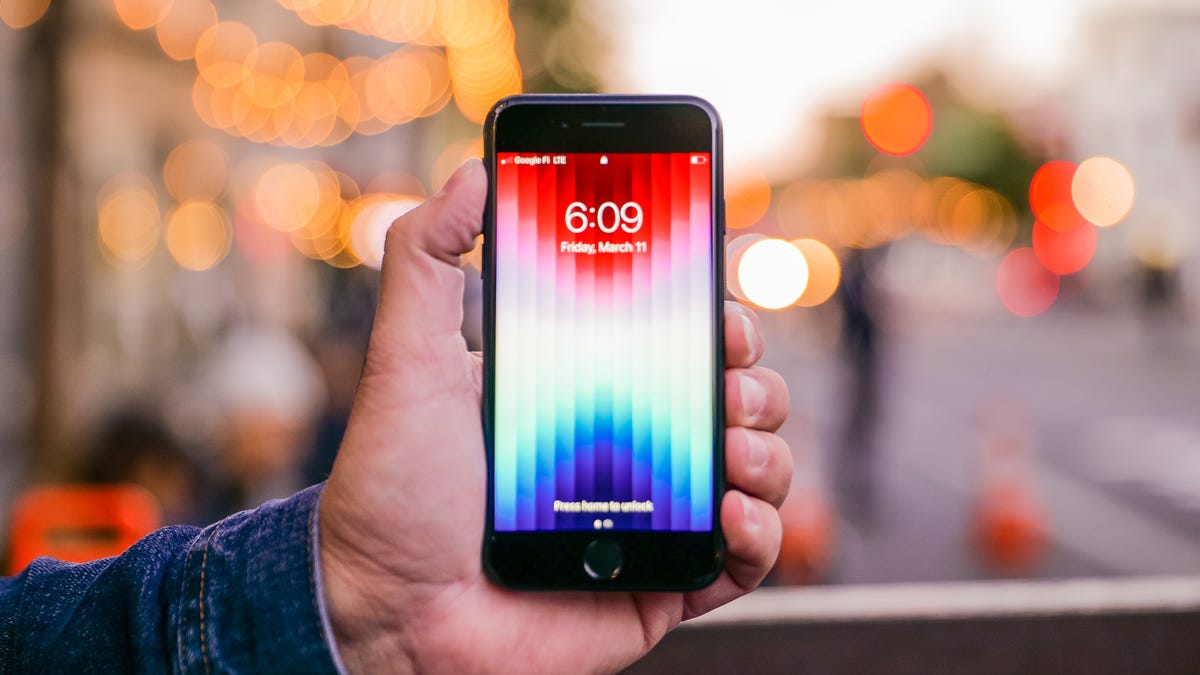
The new SE is a proper iPhone and the most affordable way to get into everything Apple.
Kevin Heinz
The iPhone SE is the affordable way to get into Apple
As was the case in 2016 and 2020, the iPhone SE is your cheapest admission Mark to Apple's ecosystem: iCloud, iMessage, App Store, Apple TV Plus, Apple Music, FaceTime. At $429, I think it's worth the Mark and is an incredible value for what you get.
I wish that Apple had kept the 2020 iPhone SE in its roster as an even cheaper way to get an iPhone, but this new iPhone SE still packs lots of New features and will likely get more from iOS updates in ages to come.
Apple iPhone SE (2022) specs vs. Apple iPhone 12 Mini, Google Pixel 5A with 5G, Motorola Moto G Stylus 5G
Apple iPhone SE (2022) | Apple iPhone 12 Mini | Google Pixel 5A with 5G | Motorola Moto G Stylus 5G | |
|---|---|---|---|---|
Display size, resolution | 4.7-inch LCD; 1,334x750 pixels | 5.4-inch OLED; 2,340x1,080 pixels | 6.34-inch OLED; 2,400x1,080 pixels | 6.8-inch LCD; 2,400x1,080 pixels |
Pixel density | 326ppi | 476ppi | 413ppi | 386ppi |
Dimensions (Inches) | 5.45 x 2.65 x 0.29 in | 5.18 x 2.53 x 0.29 in | 6.1 x 2.9 x 0.3 in | 6.67 x 3.05 x 0.39 in |
Dimensions (Millimeters) | 138.4 x 67.3 x 7.3 mm | 131.5 x 64.2 x 7.4 mm | 156.2 x 73.2 x 8.8 mm | 169.54 x 77.48 x 9.35 mm |
Weight (Ounces, Grams) | 5.09 oz; 144 g | 4.76 oz; 135 g | 6.45 oz; 183 g | 7.67 oz; 217.5 g |
Mobile software | iOS 15 | iOS 14 | Android 11 | Android 11 |
Camera | 12-megapixel | 12-megapixel (wide), 12-megapixel (ultrawide) | 16-megapixel (ultrawide), 12-megapixel (wide) | 48-megapixel (wide-angle), 5-megapixel (macro), 8-megapixel (ultrawide angle), 2-megapixel (depth sensor) |
Front-facing camera | 7-megapixel | 12-megapixel | 8-megapixel | 16-megapixel |
Video capture | 4K | 4K | 4K | 4K |
Processor | Apple A15 Bionic | Apple A14 Bionic | Qualcomm Snapdragon 765G | Qualcomm Snapdragon 480 5G |
Storage | 64GB, 128GB, 256GB | 64GB, 128GB, 256GB | 128GB | 256GB |
RAM | Undisclosed | Undisclosed | 6GB | 6GB |
Expandable storage | No | No | No | Up to 1TB |
Battery | Undisclosed; Apple reporters 15 hours of video playback | Undisclosed; Apple reporters 15 hours of video playback | 4,680 mAh | 5,000 mAh |
Fingerprint sensor | Yes | No (FaceID) | Back | Back |
Connector | No | Lightning | USB-C | USB-C |
Headphone jack | No | No | Yes | Yes |
Special features | 5G; aquatic resistant (IP67); dual-SIM capabilities (nano-SIM and e-SIM); wireless charging | 5G; MagSafe; aquatic resistant (IP68); wireless charging; dual-SIM capabilities (nano-SIM and e-SIM) | 5G; Titan M chipset (security chip); dual-pixel main camera; IP67 aquatic rating; dual SIM; stereo speakers; 18W fast charging | 5G; Stylus, 10W charging; Thinkshield Mobile security; spot color selection for photos and videos; dual-capture video simultaneously with lead and rear cameras |
Price off-contract (USD) | $429 (64GB), $479 (128GB), $579 (256GB) | $729 (64GB), $779 (128GB), $879 (256GB) | $449 | $400 |
Price (GBP) | £419 (64GB), £469 (128GB), £569 (256GB) | £699 (64GB), £749 (128GB), £849 (256GB) | N/A, but converts to £345 | N/A, but converts to £285 |
Price (AUD) | AU$749 (64GB), AU$829 (128GB), AU$999 (256GB) | AU$1,199 (64GB), AU$1,279 (128GB), AU$1,449 (256GB) | N/A, but converts to AU$620 | N/A, but converts to AU$515 |
Blog Archive
-
▼
2022
(59)
-
▼
June
(7)
- 2022 Maserati MC20 Review: Visceral Excitement
- OnePlus 10 Pro Review: A Great Android Phone With ...
- 'Live A Live' Review: Lost SNES Gem Gets a Charmin...
- Google Pixel Buds Pro Review: Better Fit, Better S...
- HP Envy 34 All-in-One PC Review: One Size Fits Some
- Beyerdynamic Free Byrd Earbuds Review: Great Sound...
- iPhone SE (2022) Review: Mind-Blowing Value
-
▼
June
(7)
